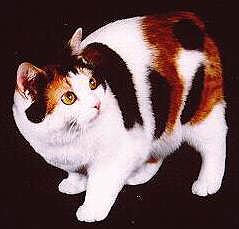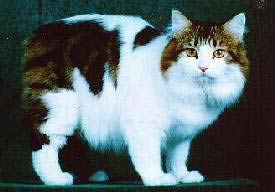 The Manx has existed as a breed for a very long time. According to Dr. D.W. Kerruish, DVM (Manxland Cattery) in his book The Manx Cat (which was revised in 1965), the breed was known on the Isle of Man two to three hundred years ago. Manx have been recognized by CFA as a breed for many years. My collection of Stud Books goes back to No. 19 in which there are several Manx registered in the late 1920s and early '30s. Since many of them were registered at that time as "details unknown," it is not possible to determine how many of these cats might have had long hair. It is known that many Manx on the Isle of Man were long coated.
The Manx has existed as a breed for a very long time. According to Dr. D.W. Kerruish, DVM (Manxland Cattery) in his book The Manx Cat (which was revised in 1965), the breed was known on the Isle of Man two to three hundred years ago. Manx have been recognized by CFA as a breed for many years. My collection of Stud Books goes back to No. 19 in which there are several Manx registered in the late 1920s and early '30s. Since many of them were registered at that time as "details unknown," it is not possible to determine how many of these cats might have had long hair. It is known that many Manx on the Isle of Man were long coated.
Dr. Kerruish is of the opinion that the Manx mutated from the British Shorthair. My personal opinion is that it is impossible to know for certain just when they mutated into a tailless cat. It is very likely that the mutation did occur on the Isle of Man but since many ships docked there, we may never know what was behind the first tailless cat. I am sure that the British Shorthair was involved! Many Isle of Man cats were imported to the US and as there were longhairs in the gene pool on the Isle of Man, it is probable that both coat lengths were behind many of the imports.
Dr. Kerruish did much research on the history of the Manx cat. In his book he states that the earliest reference to the Manx he could find is to cats owned by the famous painter Joseph Turner. He found this reference in the book, Turner's Golden Visions, by C. Lewis Hyde. In 1810, when the painter was 35, he claimed that he had seven cats that came from the Isle of Man.
Jeanie McPhee was kind enough to send me a copy of the article on Manx, written by Frances Simpson, which was published in 1902. This article is quite interesting since it states that at the turn of the century, Manx were shown in Europe with varying degrees of tails. It seems that "stubbies" could compete at that time for championship, and some of them were of top type. Ms. Simpson made remarks regarding the type she expected to see on the Manx when judging. The cats depicted in her article could well be Manx of today, and some of the Manx pictured in Dr. Kerruish's book could also compete with today's Manx. The type we see today in the Manx was apparently seen as far back as the 1800s. Therefore, it is possible that the Manx could be one of the least changed in type of any of the breeds recognized by CFA today.
Both Ms. Simpson and Dr. Kerruish mention in their writings the stump-tailed cats found in Borneo, Japan, and Malaya which are the cats we know today as Japanese Bobtails. It appears that this breed has also been around a long time! Dr. T. Tansanguan of the Faculty of Veterinary Science, Bangkok, Thailand, confirms that the Japanese Bobtail is a separate strain of cat.
Sisters Ellen and Ruth Carlson, who resided in the Chicago area, were very active in Manx as far back as the 1930s. At that time they showed in ACA as well as CFA and had the first Manx Grand Champion in ACA. In 1935 they imported a cat called "Ginger of Manx of Glen Orry." Ginger came to them from Denmark but had been born on the Isle of Man, and he was behind nearly all of the cats the Carlsons bred.
Another early breeder was Price Cross of the Dallas, Texas area. He had the Mao O'Man cattery and developed several well-known cats of that time. The one I remember seeing on pedigrees most often was Mao Patricia O'Man.
As far as I can trace, the first Grand Champion in CFA was Mrs. Kelly of An-Si who was shown in the 1950s. A black import from the Isle of Man owned by Mrs. Ann Bienemann of the Pittsburgh, Pennsylvania area, Mrs. Kelly granded in 1958.
One of the foundation queens of Tra-Mar, GC Xantha's Candice of Tra-Mar. "Candy" was highest scoring Shorthair All American in 1960. (In those early days, CFA did not have national scoring as we now know it; a magazine scored all cat shows.) Candy was the second Manx Grand Champion in CFA, earning her title in 1959. Her son, GC Tra-Mar Sunny, was twice Highest Scoring All American Midwest Cat. Another cat is Manxland Maisie. Bred and owned by Dr. Kerruish, Maisie was the dam of Manxland Mornin' Mist of Tra-Mar, a copper-eyed white who sired Sunny. These three cats are the foundation of Tra-Mar and are behind today's Tra-Mar cats, as well as many other lines.
Currently there are two Manx male Distinguished Merit cats: GC Sinleo White Irish of Shelleo, DM, a copper-eyed white, who was 13th Best Cat in the 1980-81 season; and CH Tahame's Shamen, DM (CFA's first Manx male DM), who was bred and owned by Sherman and Sandy Ross. There are several Manx female DMs.
GC Sinleo White Irish sired a son, GC Briar Brae Merphy, a red tabby who was 6th Best Cat in Championship in 1985-86. Irish's daughter, GC, GP NW Tra-Mar Limited Edition, a brown patched tabby, was 3rd Best Cat in Premiership in 1992-93. Irish is still alive, going on 17 and has never been sick a day in his life. He still bats his ping pong ball around and certainly never misses a meal!
Other cats are GC Kelsha Lacy, DM, an early brown tabby bred and owned by Kelly Tanner, and GC, GP, NW Clacritter Claudell, DM, a dilute calico bred and owned by Leslie Falteisek who was 8th Best Cat in 1983-84. Another winner for Leslie was GC, NW Clacritter Kadja, a cream tabby and white male who was CFA's 7th Best Cat in 1986-87. Best Manx (Shorthair) in 1991-92 was GC Cottori Bubba, a copper-eyed white male bred and owned by Paul and Becky Cotter. Paul and Becky had visited the Isle of Man during a military tour, but they did not purchase a Manx until they were back in the US. Their very first Manx was an Isle of Man import, a black female called Victoria who now is a very happy, fat spay.
Cymric (Longhair Manx)
 It was the 1989-90 show season before the longhair Manx were recognized, and at that time they were called Cymric. The very first Cymric to be Best of Breed was GC Kabelkim Orange Julius, a red tabby bred by Elma Sterk; 2nd Best that year was GC Clacritter Callyn, a red tabby bred by Leslie Falteisek. Even before the longhairs were recognized for championship other breeders were either working with them or including them in their breeding programs. Kelly Tanner, of Kelsha Manx, produced many of the early longhairs and Linda Morris Osborn has worked with them since long before they were accepted. Her very first longhair was Sinleo's Tuffy Mouse of Arrow. Bred by Cynthia Engstrom and owned by Linda, he is behind many of her longhair Manx. GC Tellnotails Butterfly, a calico van female bred and owned by Marlene and Ron Kelman, was Best Cymric in 1992-93. A black and white male, GC Blarney's Paddy O'Furrnutsure, is another outstanding longhair Manx bred and owned by Dick and Renee Cullen. Best Manx Longhair for 1994-95 was GC Tirion Fionan of Nufurs, a brown mackerel tabby and white male bred by Sandra Willen and owned by Susan Nuffer, Sandra Willen, and Mary Davin. Fionan was also Best Cymric in the 1993-94 show season.
It was the 1989-90 show season before the longhair Manx were recognized, and at that time they were called Cymric. The very first Cymric to be Best of Breed was GC Kabelkim Orange Julius, a red tabby bred by Elma Sterk; 2nd Best that year was GC Clacritter Callyn, a red tabby bred by Leslie Falteisek. Even before the longhairs were recognized for championship other breeders were either working with them or including them in their breeding programs. Kelly Tanner, of Kelsha Manx, produced many of the early longhairs and Linda Morris Osborn has worked with them since long before they were accepted. Her very first longhair was Sinleo's Tuffy Mouse of Arrow. Bred by Cynthia Engstrom and owned by Linda, he is behind many of her longhair Manx. GC Tellnotails Butterfly, a calico van female bred and owned by Marlene and Ron Kelman, was Best Cymric in 1992-93. A black and white male, GC Blarney's Paddy O'Furrnutsure, is another outstanding longhair Manx bred and owned by Dick and Renee Cullen. Best Manx Longhair for 1994-95 was GC Tirion Fionan of Nufurs, a brown mackerel tabby and white male bred by Sandra Willen and owned by Susan Nuffer, Sandra Willen, and Mary Davin. Fionan was also Best Cymric in the 1993-94 show season.
In February 1994 the Manx Breed Council and the Cymric Breed Council asked for Longhair Manx status for the Cymrics. This was granted by the CFA Board of Directors and became effective in May 1994. We now have a Longhair and a Shorthair division of the Manx. This has meant that it is now acceptable to intermix the Longhair and the Shorthair for breeding, and the kittens are registered as either Longhair or Shorthair, whichever is produced from a breeding. Until this time, if a Shorthair was produced in a Longhair litter, it could not be shown, no matter how typy it was.
The Manx is a short, round cat; but unfortunately, this cat CAN be too short. The genetic mutation peculiar to the Manx cat determines the length of the spinal column. A super short spine can fail to provide proper nerve and muscle endings which can result in an open spine, a lack of bowel and/or bladder control, weak hindquarters or one weak hind leg. And yet there are super short cats that are strong and healthy. Once a Manx kitten gets past the age of six months the majority of well-cared-for pets live long lives - 15 or more years is not an uncommon lifespan. Normally Manx are extremely hearty cats and are not prone to upper respiratory problems.
Manx are very playful cats as a rule. They can jump higher than anyone would imagine, and it is not uncommon to find them perching on the highest point in any room. They have extremely powerful hindquarters. One Manx owner states that Manx are the feline sports cars of the cat world with their acceleration and quick turns. They have many doglike characteristics, and will retrieve, bury their toys, etc. Manx can often be either one-person or one-family cats and once they bond with someone, it is difficult for many of them to be happy in a different home. On the other hand, there are also those Manx that readily accept attention from any human source.
I would like to thank all the Manx breeders for willingly sharing information for this article.
by Marion Hall
Copyright 1995-2000 The Cat Fanciers' Association